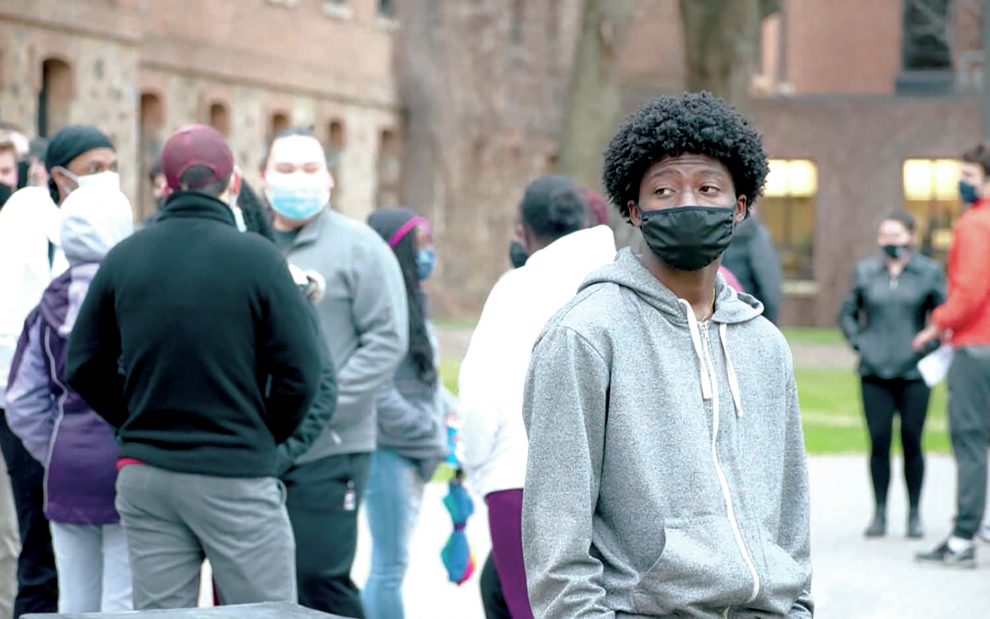On April 18, 2021 nearly 100 students gathered in near-freezing temperatures at Saint John’s University in Collegeville, Minnesota for a prayerful vigil following the killing of Daunte Wright by police officers in Brooklyn Center, Minnesota. The vigil was part of a series of programs sponsored by the campus ministry department concerning racial justice. Student leaders, who in other years would have been busy organizing retreats and service immersion trips, directed their energy and attention to overcoming the sin of racism. While public health restrictions due to the COVID-19 pandemic made many campus ministry programs difficult to organize, students desired to be together and have their voices heard. So they found a way to make that happen.
Unfortunately, many students don’t have the chance to participate in such experiences during college. While large Catholic universities, Ivy League schools, and some other colleges have well-funded campus ministry programs with dedicated staff, many campuses—especially community colleges and those serving first-generation students—have little to no ministry programming. Moreover, even on a campus where the church is present, it sometimes reflects only one style of Catholicism. For example, not all students identify with the evangelical model of American Catholicism used in many well-known campus ministry programs. Some students report feeling unwelcome due to their racial, political, or sexual identities.
Margaret Nuzzolese Conway, director of campus ministry at Saint John’s University, says the pandemic “made supporting each other even more important.” From familial and interpersonal dynamics that were intensified by lockdowns to an increasingly polarized political context, students were searching for social, psychological, and spiritual resources. “Campus ministry programs are challenged to accompany students in this difficult time,” she says.
The Springtide Research Institute’s 2020 report, “The State of Religion & Young People,” shows college-age adults are searching for authentic relationships and communities where they can be heard. Pope Francis emphasizes the importance of accompanying young adults in a spirit of synodality. In Christus Vivit (Christ Is Alive!), the 2019 apostolic exhortation on youth and young adults, the pope insists that “youth ministry has to be synodal; it should involve a ‘journeying together.’ ” With such an approach, he continues, “we can move towards a participatory and co-responsible Church.”
With the right strategies and resources, the church can engage college students and strengthen a sense of Catholic identity at both the personal and collective levels. Small faith communities can play an important role, particularly in creating welcoming places to meet students where they are.
Small faith communities
Small faith communities take on many forms. Essentially, they consist of small groups—usually of 6 to 12 people—that gather regularly to share faith and life. At their best, in their range of approaches and methods small faith groups offer safe spaces for students to voice their experiences and to listen to one another. In more profound ways than larger settings, small faith groups help young people form identity, encounter one another, deepen their relationships with God, and exercise their baptismal responsibility as the body of Christ.
In God’s Quad: Small Faith Communities on Campus and Beyond (Orbis Books), Christopher Derige Malano and I highlight 12 different models of student organizing from the United States and five other countries. Many groups, such as small Christian communities in Kenya or at Duke University and Purdue University in the United States, organize around the gospel reading of the upcoming Sunday. Others, such as sections of All India Catholic University Federation or the student ambassador groups of Catholic Relief Services, focus on addressing specific social justice issues. Some, such as the Christian Life Community groups at Boston College, follow a specific spirituality associated with a religious congregation (Jesuit, Benedictine, etc.). Others, such as the Unión Nacional de Estudiantes Católicos in Peru, mobilize students to reflect on their experiences in light of the gospel according to the see-judge-act method.
Not all students identify with the evangelical model of American Catholicism used in many well-known campus ministry programs.
Advertisement
In the face of the pandemic, student faith groups have demonstrated a dynamic sense of resiliency. Many campus ministries, such as the Newman Center at Washington University in St. Louis, moved some groups to online meetings. Others helped create “praying pods,” whereby members living in dorms together met in person, often outside, as a dedicated group. At Manhattan College in the Bronx, New York, the peer ministry group shifted from in-person meetings every two weeks to virtual meetings every week. During these meetings, 10 to 15 students would gather to share their highs and lows of the week, pray, and discuss a theme. According to Meggie Black, one of the student coordinators of the group, the 90-minute meeting offered a “safe space for students to talk about things they could not talk about anywhere else and to connect that to spirituality.”
At a time when many students feel disconnected from the church, these spaces, both online and in person, offer a way for students to manage the disruptions and stress brought about by their wider social contexts. They also help support students in making their voices heard.
A synodal approach
To journey together in such a way demands that young adults exercise their agency and responsibility on this path, not as the church of the future but as the church of today. As Pope Francis points out in Christus Vivit, they ought to be seen as “protagonists of change.” Such an approach to youth ministry stands in contrast to both clerical and consumeristic models that diminish the agency of young people.
Small faith groups where students are given space to lead, organize prayer, manage budgets, plan actions, and facilitate conversations become laboratories in synodality. For Black, the student-led peer ministry group at Manhattan College enables students “who are often on their own for the first time to take charge of their spiritual and mental well-being.” This growth in leadership and initiative in faith programming are lessons young adults can take with them when they graduate. For Black, this will mean serving as a full-time volunteer in the Jesuit Volunteer Corps Northwest. For others, it will mean volunteering in their local parish or with nonprofits; studying theology; or finding vocations as pastoral ministers, priests, or vowed religious.
Pope Francis emphasizes the importance of accompanying young adults in a spirit of synodality.
However, the transition to postgraduate life can be difficult, especially if there are limited opportunities that value young adults’ creativity and leadership skills. Parishes and dioceses must listen to these leaders, make space for them in leadership roles, and help them create communities of young Catholic professionals.
For many of the same reasons that young people join together in small faith groups, these small faith groups find value in joining together in wider networks. The International Movement of Catholic Students (IMCS-Pax Romana), a global network of student communities run by young adults, is celebrating its centenary this year. By joining together in this wider network, local student groups amplify the voices of their members across borders and with people in positions of power, including at the United Nations. But this global voice, as IMCS-Pax Romana insists, is only valuable if it’s based on the listening, experience, and action of local groups. In its statement to the 2018 Synod of Bishops, IMCS-Pax Romana emphasizes the importance of such spaces: “The experience of small communities, in their many forms, enables students and young adults to experience a more authentic and relational sense of church. . . . This can be particularly transformative for young people who feel at the margins of the church, including women, LGBTQ youth, and migrants.”
The pope’s call for synodal models in youth and young adult ministry offers an important challenge for the church after the COVID-19 pandemic—a challenge for young adults’ voices to be heard among their peers and in society. Small faith groups, when organized as welcoming spaces of prayer, reflection, and action, are critical components in this regard. Student faith groups can help young adults understand their role in the church, not as passive observers or consumers of a spiritual product but as active members of the body of Christ, as adult Christians, with responsibilities in both the church and society. Catholic young adults are ready and able to lead the church forward together. Are we ready to listen and accompany them?
This article also appears in the September 2021 issue of U.S. Catholic (Vol. 86, No. 9, pages 16-18). Click here to subscribe to the magazine.
Image: Jacob Gathje














Add comment